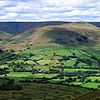Chrome Hill
| Chrome Hill | |
|---|---|
 Chrome Hill viewed from the southwest | |
| Highest point | |
| Elevation | c. 425 m (c. 1394 ft) |
| Geography | |
| Location | Peak District, England |
| OS grid | SK070673 |
| Topo map | OS Landranger 119 |
Chrome Hill /ˈkruːm/ is a limestone reef knoll[1] in Derbyshire, England, in the upper Dove valley beside the border with Staffordshire. It is adjacent to Parkhouse Hill, another reef knoll.
Chrome Hill was declared open access land[2] under the provisions of the Countryside and Rights of Way Act 2000. However, the only access from the north west remains along a concessionary footpath. Chrome Hill contains good exposures of Gigantoproductus fossils; it is part of a designated Site of Special Scientific Interest[3] which makes it an offence for visitors to remove geological samples.
In 1997 the writer Jeff Kent discovered that a double sunset could be seen against Chrome Hill from the southern flank of Parkhouse Hill. Two years later he discovered that a similar event took place from nearby Glutton Bridge, on the upper valley of the River Dove, which was more easily accessible.[4] The phenomenon is visible from Glutton Bridge in good weather for a short period around the summer solstice, when the sun sets just to the southwest of the summit of Chrome Hill, begins to re-emerge almost immediately afterwards from its steep northeastern slope before fully reappearing and later sets for a second and final time at the foot of the hill. The precise event and its location are described in Kent's book The Mysterious Double Sunset.[5]
Chrome Hill has had songs written in its honour by the Norwegian musicians Sigurd Hole (Chrome Hill[6]) and Jonas Howden Sjøvaag (Up on Chrome Hill[7]). In 2008 the Norwegian jazz quartet Damp changed its name to Chrome Hill.
Coordinates: 53°12′10″N 1°53′48″W / 53.20273°N 1.89666°W
References[]
- ^ Wolverson Cope, F. (1999). The Peak District. Geologist' Association Guide No. 26 (3rd revised ed.). The Geologists' Association. ISBN 0-900717-11-4.
- ^ Townroe, P.M. (2003). Appeal Decision (PDF). The Planning Inspectorate. CROW/2/M/03/735. Archived from the original (PDF) on 16 May 2011.
- ^ "SSSI Citation" (PDF). Natural England. Archived from the original (PDF) on 27 April 2012. Retrieved 5 January 2010.
- ^ The Mysterious Double Sunset, pages 102, 110, 111 and 113–114, Jeff Kent, ISBN 0-9529152-5-1, Witan Books, 2001.
- ^ The Mysterious Double Sunset, especially photographs 23 (i)-(iv) and page 200, Jeff Kent, ISBN 0-9529152-5-1, Witan Books, 2001.
- ^ Eple Trio (2007). Made This. NORCD. Catalog NORCD0766.
- ^ Navyelectre (2008). The Mourning. Shipwreckords. ASIN B000YB6VG2.
| Wikimedia Commons has media related to Chrome Hill. |
- Mountains and hills of the Peak District
- Mountains and hills of Derbyshire
- Sites of Special Scientific Interest in Derbyshire



